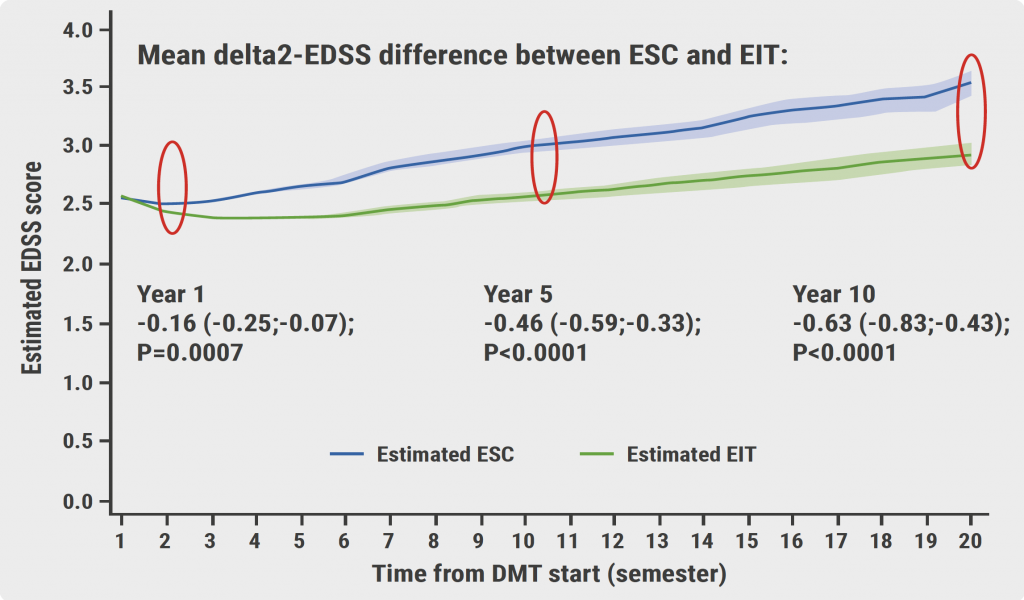https://doi.org/10.55788/45da9aa4
Chronic active/smouldering lesions, visible as PRLs, are associated with clinical disease severity and neuro-axonal damage [1]. A new study aimed to assess the effects of anti-CD20 antibody therapy on these lesions. B-cell lineage lymphocytic subpopulations in chronic active lesions were also analysed, including the consequences of their depletion.
A longitudinal, clinical, MRI study was set up in which 4 European academic hospitals participated [2]. Included were 68 adults with relapsing-remitting MS or progressive MS; 42 received anti-CD20 treatment, while 26 chose not to be treated. All participants underwent longitudinal 3T susceptibility-based MRI for PRL detection and quantitative-susceptibility mapping (QSM) analysis. The median follow-up for treated and untreated participants was 26 and 31 months, respectively. Dr Pietro Maggi (Saint-Luc University Hospital, Belgium) presented the results.
A total of 346 white-matter lesions were studied: 185 PRLs (133 treated and 52 untreated) and 161 non-PRLs (110 treated and 51 untreated). At follow-up, the paramagnetic rim disappeared in none of the 133 treated PRLs. The researchers did not find a significant treatment effect on PRLs versus non-PRLs for log-lesion volume (P=0.16), QSM (P=0.56), or T1 values (P=0.34). PRLs were larger (P<0.0001) and expanded over time (P=0.009), “confirming their nasty, destructive phenotype,” Dr Maggi said.
In chronic active lesions, lymphocytes constituted 6.8% of all immune cells; they included 4.3% of CD20+ B cells, 20% of antibody-producing plasmablasts, 75.5% of activated T cells, and 0.2% of natural-killer cells. A gene-regulatory network (GRN) machine-learning analysis predicted that depletion of CD20+ B cells, plasmablasts, and T cells would each affect genes highly expressed by microglia and dendritic cells.
Thus, anti-CD20 therapies did not fully resolve PRLs after 2 years of follow-up. The lack of CD20+ B cells in chronic active lesions and the inefficient passage of anti-CD20 antibodies across the blood-brain-barrier could be possible explanations
- Absinta M ,et al. JAMA Neurol. 2019;76(12):1474–1483.
- Maggi P. Chronic active multiple sclerosis lesions are poorly responsive to anti-CD20 antibody treatment. Abstract O118, ECTRIMS 2022, 26–28 October, Amsterdam, Netherlands.
Copyright ©2022 Medicom Medical Publishers
Posted on
Previous Article
« How neoadjuvant atezolizumab changes T-cell dynamics in early NSCLC Next Article
Physical impairment is present before perceived MS onset »
« How neoadjuvant atezolizumab changes T-cell dynamics in early NSCLC Next Article
Physical impairment is present before perceived MS onset »
Table of Contents: ECTRIMS 2022
Featured articles
Letter from the Editor
Diagnosis and Prediction of Disease Course
A case for including optic nerve lesions in the McDonald criteria
Cerebrospinal fluid kappa-free light chains for MS diagnosis
Early, non-disabling relapses increase disability accumulation
Physical impairment is present before perceived MS onset
Chronic active MS lesions respond poorly to anti-CD20 antibodies
Treatment: Trials & Strategies
Dimethyl fumarate reduces the risk of a first clinical event in RIS
How and when to make a timely switch to high-efficacy DMT
Comparing real-world effectiveness of DMTs
Study fails to show non-inferiority of rituximab to ocrelizumab
Autologous haematopoietic stem cell transplantation versus DMTs
Progressive MS
Stem cell transplantation not superior to natalizumab in progressive MS
Efficacy of DMTs fades away in secondary progressive MS
Smartphone tapping can help detect progressive MS
Paediatric MS
Early treatment with DMT effective in paediatric-onset MS
Fingolimod in paediatric MS: results of up to 6 years
Switching treatment after initial platform injectable DMT: real-world data
Pregnancy
Pregnancy and infant outcomes in women receiving ocrelizumab
New safety data of anti-CD20 mAbs around pregnancy
MS activity and pregnancy outcomes after long-term use of natalizumab
NMOSD
Ravulizumab significantly reduced relapses in AQP4+ NMOSD
NMOSD patients are cognitively impaired regardless of serostatus
Evidence-based consensus on pregnancy in NMOSD
COVID-19
COVID-19 and MS: lessons learned thus far
Ocrelizumab and fingolimod increase the risk of COVID-19 and of worse outcomes
Humoral and cellular immune responses after SARS-CoV-2 vaccination
Miscellaneous
Re-myelination strategies in MS still pose many unanswered questions
MS associated with a broader Epstein-Barr virus specific T-cell receptor repertoire
Cognitive rehab and mindfulness reduce cognitive complaints in MS
Related Articles

December 4, 2023
Early intensive treatment enhances long-term clinical outcomes
August 18, 2021
Typing behaviour to remotely monitor clinical MS status
© 2024 Medicom Medical Publishers. All rights reserved. Terms and Conditions | Privacy Policy

